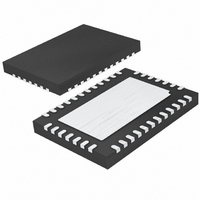LTC3586EUFE#PBF Linear Technology, LTC3586EUFE#PBF Datasheet - Page 28

LTC3586EUFE#PBF
Manufacturer Part Number
LTC3586EUFE#PBF
Description
IC MANAGER USB PWR HI-EFF 38QFN
Manufacturer
Linear Technology
Datasheet
1.LTC3586EUFEPBF.pdf
(36 pages)
Specifications of LTC3586EUFE#PBF
Applications
Handheld/Mobile Devices
Voltage - Supply
4.35 V ~ 5.5 V
Operating Temperature
-40°C ~ 85°C
Mounting Type
Surface Mount
Package / Case
38-QFN
Lead Free Status / RoHS Status
Lead free / RoHS Compliant
Current - Supply
-
Available stocks
Company
Part Number
Manufacturer
Quantity
Price
LTC3586/LTC3586-1
applicaTions inForMaTion
USB Inrush Limiting
When a USB cable is plugged into a portable product,
the inductance of the cable and the high-Q ceramic input
capacitor form an L-C resonant circuit. If the cable does
not have adequate mutual coupling or if there is not much
impedance in the cable, it is possible for the voltage at
the input of the product to reach as high as twice the
USB voltage (~10V) before it settles out. In fact, due to
the high voltage coefficient of many ceramic capacitors, a
nonlinearity, the voltage may even exceed twice the USB
voltage. To prevent excessive voltage from damaging the
LTC3586/LTC3586-1 during a hot insertion, it is best to
have a low voltage coefficient capacitor at the V
the LTC3586/LTC3586-1. This is achievable by selecting an
MLCC capacitor that has a higher voltage rating than that
required for the application. For example, a 16V, X5R, 10µF
capacitor in a 1206 case would be a better choice than a
6.3V, X5R, 10µF capacitor in a smaller 0805 case.
Alternatively, the soft connect circuit (Figure 7) can be
employed. In this circuit, capacitor C1 holds MP1 off
when the cable is first connected. Eventually C1 begins
to charge up to the USB input voltage applying increasing
gate support to MP1. The long time constant of R1 and
C1 prevent the current from building up in the cable too
fast thus dampening out any resonant overshoot.
Battery Charger Stability Considerations
The LTC3586/LTC3586-1’s battery charger contains both
a constantvoltage and a constant-current control loop.
The constantvoltage loop is stable without any compen-
sation when a battery is connected with low impedance
leads. Excessive lead length, however, may add enough
series inductance to require a bypass capacitor of at least
1µF from BAT to GND. Furthermore, when the battery is
5V USB
INPUT
USB CABLE
Figure 7. USB Soft Connect Circuit
C1
100nF
Si2333
MP1
R1
40k
C2
10µF
V
GND
LTC3586-1
LTC3586/
BUS
BUS
3586 F07
pin to
disconnected, a 4.7µF capacitor in series with a 0.2Ω to
1Ω resistor from BAT to GND is required to keep ripple
voltage low.
High value, low ESR multilayer ceramic chip capacitors
reduce the constant-voltage loop phase margin, possibly
resulting in instability. Ceramic capacitors up to 22µF may
be used in parallel with a battery, but larger ceramics should
be decoupled with 0.2Ω to 1Ω of series resistance.
In constant-current mode, the PROG pin is in the feed-
back loop rather than the battery voltage. Because of the
additional pole created by any PROG pin capacitance,
capacitance on this pin must be kept to a minimum. With
no additional capacitance on the PROG pin, the battery
charger is stable with program resistor values as high
as 25k. However, additional capacitance on this node
reduces the maximum allowed program resistor. The pole
frequency at the PROG pin should be kept above 100kHz.
Therefore, if the PROG pin has a parasitic capacitance,
C
the maximum resistance value for R
BUCK REGULATOR APPLICATIONS SECTION
Buck Regulator Inductor Selection
Many different sizes and shapes of inductors are avail-
able from numerous manufacturers. Choosing the right
inductor from such a large selection of devices can be
overwhelming, but following a few basic guidelines will
make the selection process much simpler.
The buck converters are designed to work with inductors
in the range of 2.2µH to 10µH. For most applications a
4.7µH inductor is suggested for both buck regulators.
Larger value inductors reduce ripple current which im-
proves output ripple voltage. Lower value inductors result
in higher ripple current and improved transient response
time. To maximize efficiency, choose an inductor with a
low DC resistance. For a 1.2V output, efficiency is reduced
about 2% for 100mΩ series resistance at 400mA load cur-
rent, and about 2% for 300mΩ series resistance at 100mA
PROG
R
PROG
, the following equation should be used to calculate
≤
2
π •
100
kHz C
1
•
PROG
PROG
:
3586fb













